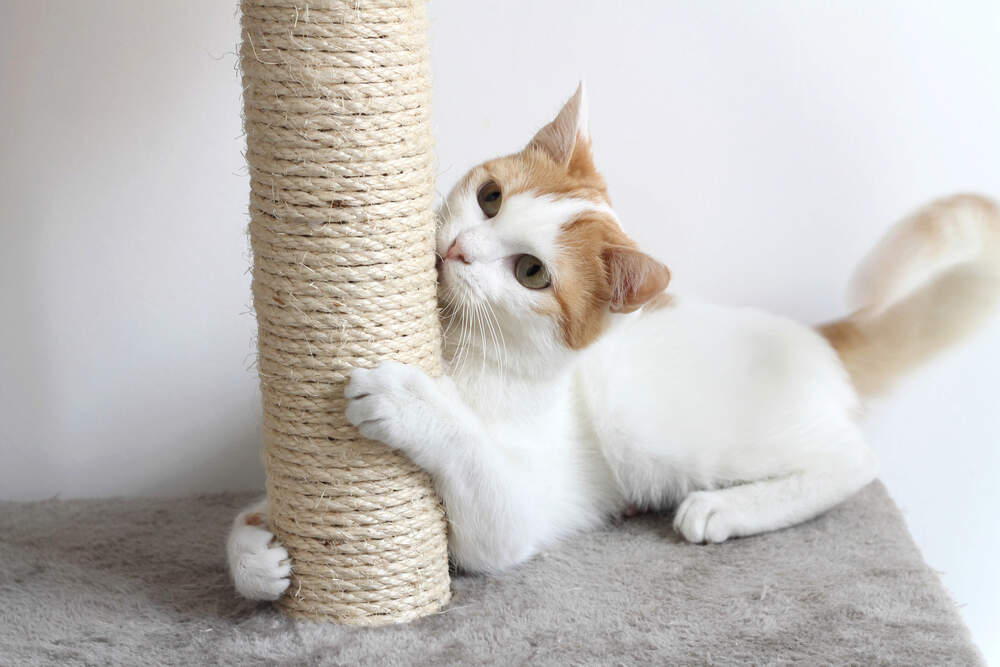How to Get a Cat to Trust You
Cats can be nervous and shy for a variety of reasons. Maybe you've encountered an outdoor cat whose owner left him behind, and now he doesn't trust people. Or maybe you've adopted a cat who wasn't socialized well as a kitten, and now he's hiding in a closet. If you have a nervous kitty, how can you get your cat to trust you? Understanding a cat's body language, respecting boundaries, and taking things slow are vital steps to gaining a cat's trust.
Understanding Cat Body Language
Cats are constantly communicating, even if they don't make noise. Signs that seem subtle to you may be strong attempts to communicate in your cat's world. By learning just a few simple cat “words," you can usually understand what they're trying to say and when it's good to approach and when it's not.
The tail is one powerful indicator. A tail held high or straight up indicates happiness and confidence. A slowly moving tail means the cat is concentrating. A fast-twitching tail can indicate annoyance or nervousness. A puffy tail means your cat is scared or preparing for a fight.
Eyes are also a major part of cat language. If you see a cat with dilated eyes (large pupils), then steer clear. This is usually a sign he's on high alert. When a cat's eyes are half-closed, that means he feels relaxed and comfortable. He may slow blink to show he likes (or even loves) you.
A cat standing with an arched back thinks he is in for a fight, so give him space. A cat that rolls on his back and shows his belly is demonstrating he trusts you. He's probably not asking for a belly rub, though, as tempting as that may be.
When trying to gain a cat's trust, it's important to observe these clues and act accordingly. A nervous cat, for example, is on high alert and doesn't want to be touched. Even if he isn't afraid of you, he doesn't want you to try to pet him, because he wants to stay aware of his surroundings and be ready to defend himself.
How to Get an Outdoor Cat to Trust You
If you see a cat outside, you might want to gain her trust so you can help her. This process can take some time simply because you have fewer interactions.
Start by leaving food and water outside for the kitty. You might want to set up an outdoor cat house as well. After she gets used to eating food you've left for her, start sitting outside some distance from the food. Let her get used to eating in your presence, and slowly move closer to her.
Over time, she may come up to you. Extend your hand and let her sniff it. Only give her a gentle pet on the head or back if she rubs against you. If she shies away, that might mean she doesn't like how your hand smells. Don't force a pet. If you follow this protocol, she'll eventually learn you can be trusted to pet her only when she wants to be touched.
After you've established this rapport, you might leave your door open and occasionally invite her inside. She may slowly start spending more time indoors. If you have another cat, take the outdoor cat to a veterinarian for a full health checkup before letting them interact. If you become the cat parent, put a Comfort Zone Calming Collar on her. The collar releases calming pheromones to tell her she's safe, even as she explores the outside world.
Remember, not all outdoor cats will trust you. If the cat is feral rather than a stray, she's never known a human and might always be skittish. If she has a tipped ear, she's likely been in a trap-neuter-release (TNR) program.1 (A TNR program vaccinates and spays/neuters the outdoor kitty, then releases them. The tipped ear is a sign they've already been trapped.) If her ear isn't tipped, you might want to contact your local rescue and see if there is a barn-adopting program or a TNR program that can help.
How to Get an Indoor Cat to Trust You
What if you've adopted a cat, but he still doesn't trust you? If he's indoors and hiding, there are several things you can do to gain his trust. First, give him some space. Cats often need to hide for several days when they're in a new home because of all the scents and sounds. Give him a small room that's all his and away from the noise and other pets.2 Keep his food, water, and litter in the room, along with some bedding or clothing that smells like you and a comfy cat bed.
Set up Comfort Zone calming products around the house to help his "e-meow-tional" health and help him feel safe, happy, and calm. These are designed to mimic a cat's natural pheromones, letting him know everything's okay. Plug the Comfort Zone Calming Diffuser into rooms where he spends the most time, or use the Comfort Zone Multi-Cat Diffuser if you have more than one kitty.
Visit him several times a day. Put out extra-enticing treats, such as wet treats that smell like tuna, and set them between you and where your cat is hiding. Over time, he'll start venturing closer to you to get the treats. (If you have other pets, keep them in separate rooms until they get used to each other's scents and sounds.)
When he's confident enough to journey into the rest of the house, keep things as calm as possible. Make sure he has a way to escape back to the room or corner where he feels safe. Set out a few enclosed cat beds in different parts of the house, including one a little closer to the family room. Put a Comfort Zone Calming Collar on him, so he has calming signals with him as he journeys throughout your home. Set up spaces that are all his, like cat trees, condos, and window perches. He'll feel more confident if he has high spaces to escape to.
Always wait for him to approach you. Keep some tasty treats in your pocket to entice him, or get a feather wand and pull him into a gentle game of "hunt the prey."
When he does come near, move slowly and talk softly. Just like you would for an outdoor cat, extend your hand for him to sniff. Wait to pet him until he rubs against your hand. Only pet him around the head or back, where cats prefer to be petted, and respect his boundaries. With time and patience, he'll learn that you only bring good experiences. This is a great way to build trust, but it does take time.
You can gain the trust of a cat, whether he lives indoors with you or outside. Just remember the process takes time, love, and patience and should be done on your cat's terms. Understanding your cat's body language is a good place to start.
1. For All Animals. "Community Cats and Trap-Neuter-Return - FAQs." ForAllAnimals.org, http://www.forallanimals.org/community-cats-and-trap-neuter-return-faqs/.
2. Elliott, Pippa. "How to Gain a Cat's Trust." WikiHow, 12 February 2021, https://www.wikihow.com/Gain-a-Cat%27s-Trust.






